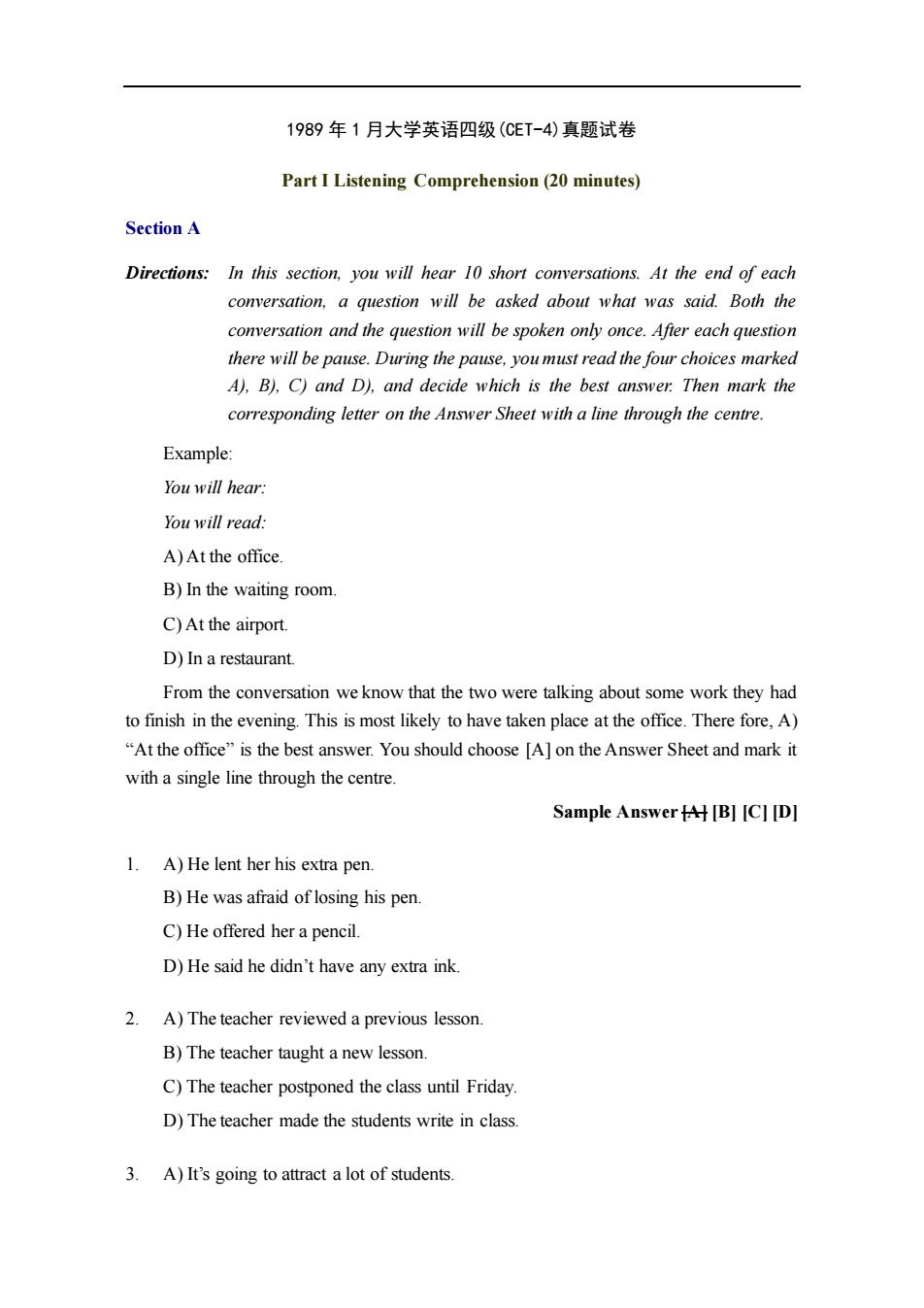
1989年1月大学英语四级(CET-4)真题试卷PartIListening Comprehension (20 minutes)Section ADirections:In this section, you will hear lo short conversations. At the end of eachconversation, a question will be asked about what was said. Both theconversation and the question will be spoken only once. Afier each questionthere will be pause. During the pause, you must read the four choices markedA),B),C)and D),and decide which is the best answer:Then mark thecorresponding letter ontheAnswer Sheetwitha line throughthe centre.Example:You will hear:You will read:A)Atthe officeB) In the waiting room.C)At the airport.D) In a restaurantFrom the conversation we know that the two were talking about some work they hadto finish in the evening. This is most likely to have taken place at the office. There fore, A)"*At the office" is the best answer. You should choose [A] on the Answer Sheet and mark itwith a single line through the centre.Sample Answer[B] [C] [D]1A) He lent her his extra penB) He was afraid of losing his penC) He offered hera pencil.D) He said he didn't have any extra ink.2. A) The teacher reviewed a previous lessonB) The teacher taught a new lesson.C) The teacher postponed the class until Friday.D) The teacher made the students write in class.3.A)It'sgoingtoattractalotof students
1989 年 1 月大学英语四级(CET-4)真题试卷 Part I Listening Comprehension (20 minutes) Section A Directions: In this section, you will hear 10 short conversations. At the end of each conversation, a question will be asked about what was said. Both the conversation and the question will be spoken only once. After each question there will be pause. During the pause, you must read the four choices marked A), B), C) and D), and decide which is the best answer. Then mark the corresponding letter on the Answer Sheet with a line through the centre. Example: You will hear: You will read: A) At the office. B) In the waiting room. C) At the airport. D) In a restaurant. From the conversation we know that the two were talking about some work they had to finish in the evening. This is most likely to have taken place at the office. There fore, A) “At the office” is the best answer. You should choose [A] on the Answer Sheet and mark it with a single line through the centre. Sample Answer [A] [B] [C] [D] 1. A) He lent her his extra pen. B) He was afraid of losing his pen. C) He offered her a pencil. D) He said he didn’t have any extra ink. 2. A) The teacher reviewed a previous lesson. B) The teacher taught a new lesson. C) The teacher postponed the class until Friday. D) The teacher made the students write in class. 3. A) It’s going to attract a lot of students
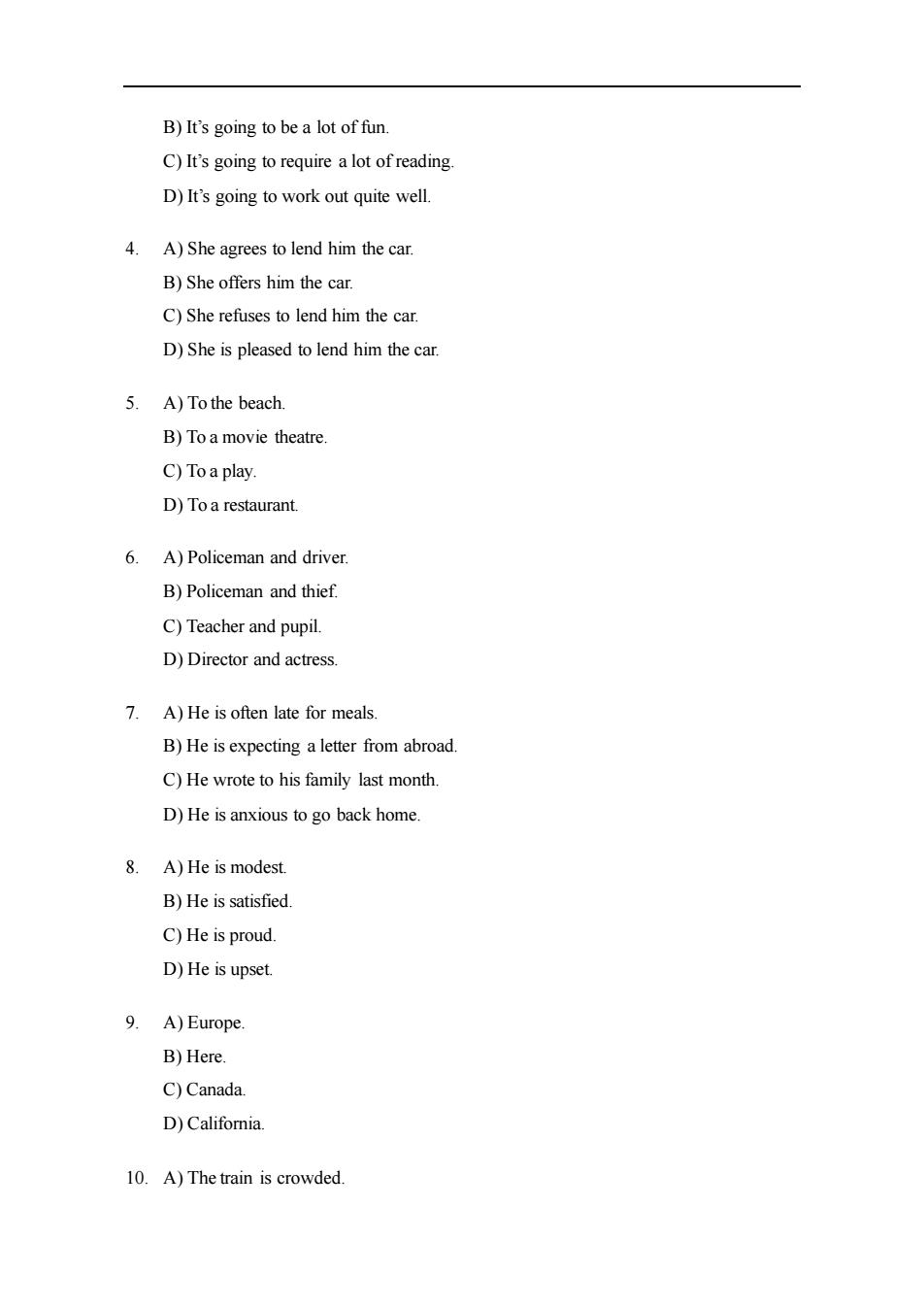
B) It's going to be a lot of funC) It's going to require a lot of reading.D) It's going to work out quite well4.A) She agrees to lend him the car.B) She offers him the car.C)SherefusestolendhimthecarD) She is pleased to lend him the car.5.A) To the beach.B) To a movie theatre.C) To a play.D) To a restaurant.6.A) Policeman and driver.B) Policeman and thief.C) Teacher and pupil.D) Director and actress.1A) He is often late for mealsB) He is expecting a letter from abroad.C) He wrote to his family last monthD) He is anxious to go back home.8.A)He is modest.B) He is satisfied.C) He is proud.D) He is upset.9.A) Europe.B) Here.C) Canada.D) California.10.A) The train is crowded
B) It’s going to be a lot of fun. C) It’s going to require a lot of reading. D) It’s going to work out quite well. 4. A) She agrees to lend him the car. B) She offers him the car. C) She refuses to lend him the car. D) She is pleased to lend him the car. 5. A) To the beach. B) To a movie theatre. C) To a play. D) To a restaurant. 6. A) Policeman and driver. B) Policeman and thief. C) Teacher and pupil. D) Director and actress. 7. A) He is often late for meals. B) He is expecting a letter from abroad. C) He wrote to his family last month. D) He is anxious to go back home. 8. A) He is modest. B) He is satisfied. C) He is proud. D) He is upset. 9. A) Europe. B) Here. C) Canada. D) California. 10. A) The train is crowded
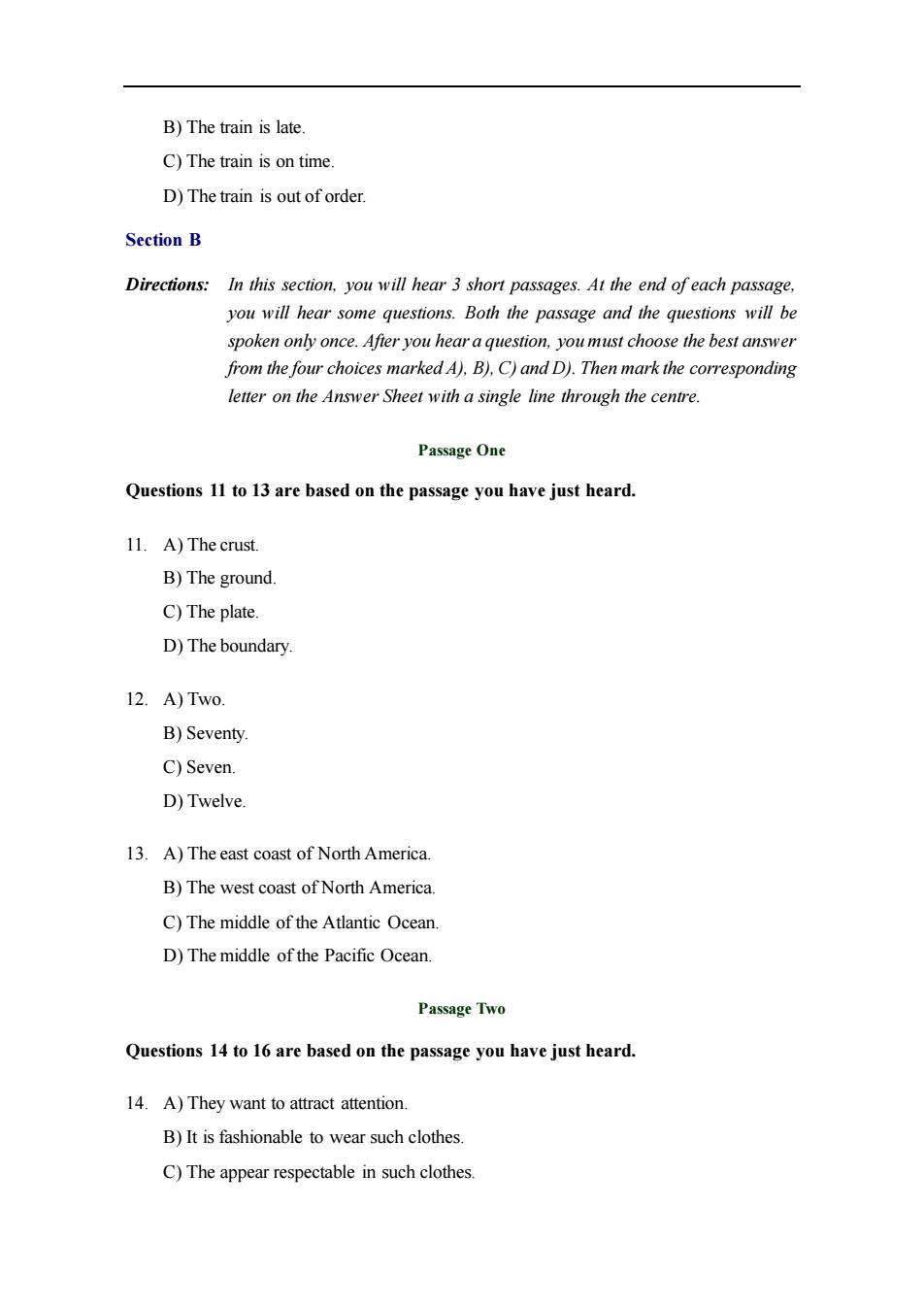
B) The train is late.C) The train is on time.D) The train is out of orderSection BDirections:In this section, you will hear 3 short passages. At the end of each passage,you will hear some questions. Both the passage and the questions will bespoken only once. Afier you heara question, you must choose the best answerfrom the four choices marked A), B),C) and D). Then mark the correspondingletter ontheAnswerSheetwithasingle linethroughthecentrePassage OneQuestions 1l to 13 are based on the passage you have just heard.11. A)The crustB) The ground.C) The plate.D) The boundary.12. A) Two.B) Seventy.C) Seven.D) Twelve.13.A)Theeastcoast of NorthAmerica.B) The west coast of North America.C) The middle of the Atlantic Ocean.D) The middle of the Pacific OceanPassage TwoQuestions 14 to 16 are based on the passage you have just heard.14. A) They want to attract attention.B) It is fashionable to wear such clothes.C)The appearrespectable in such clothes
B) The train is late. C) The train is on time. D) The train is out of order. Section B Directions: In this section, you will hear 3 short passages. At the end of each passage, you will hear some questions. Both the passage and the questions will be spoken only once. After you hear a question, you must choose the best answer from the four choices marked A), B), C) and D). Then mark the corresponding letter on the Answer Sheet with a single line through the centre. Passage One Questions 11 to 13 are based on the passage you have just heard. 11. A) The crust. B) The ground. C) The plate. D) The boundary. 12. A) Two. B) Seventy. C) Seven. D) Twelve. 13. A) The east coast of North America. B) The west coast of North America. C) The middle of the Atlantic Ocean. D) The middle of the Pacific Ocean. Passage Two Questions 14 to 16 are based on the passage you have just heard. 14. A) They want to attract attention. B) It is fashionable to wear such clothes. C) The appear respectable in such clothes
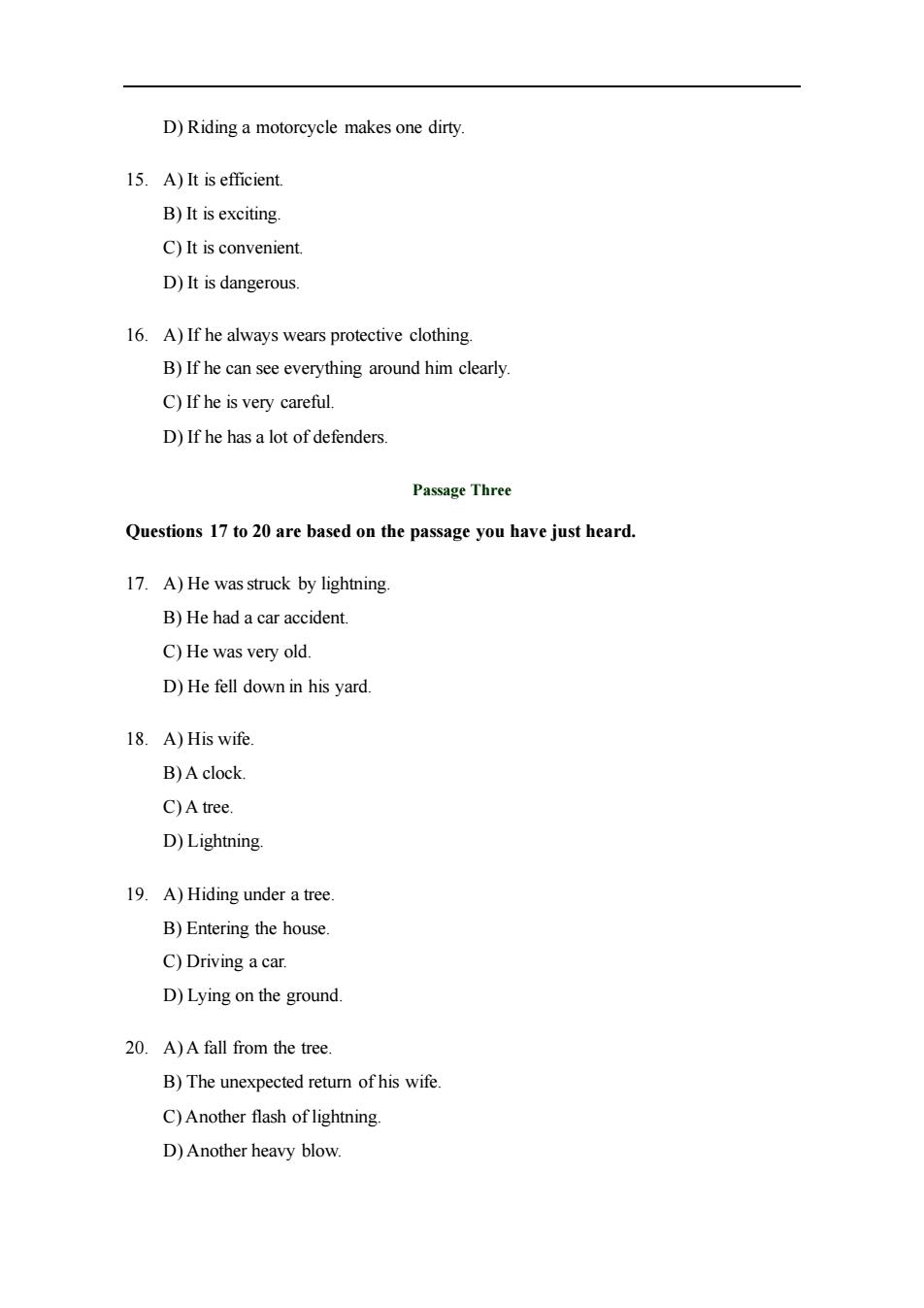
D) Riding a motorcycle makes one dirty15. A) It is efficient.B) It is exciting.C) It is convenient.D) It is dangerous.16.A)IfhealwayswearsprotectiveclothingB) If he can see everything around him clearlyC) If he is very careful.D) If he has a lot of defenders.Passage ThreeQuestions 17 to 20 are based on the passage you have just heard.17. A) He was struck by lightningB) He had a car accidentC) He was very old.D) He fell down in his yard18. A) His wifeB)A clock.C)A tree.D) Lightning.19. A) Hiding under a tree.B) Entering the house.C) Driving a car.D) Lying on the ground.20. A)A fall from the tree.B) The unexpected return of his wifeC) Another flash of lightningD) Another heavy blow
D) Riding a motorcycle makes one dirty. 15. A) It is efficient. B) It is exciting. C) It is convenient. D) It is dangerous. 16. A) If he always wears protective clothing. B) If he can see everything around him clearly. C) If he is very careful. D) If he has a lot of defenders. Passage Three Questions 17 to 20 are based on the passage you have just heard. 17. A) He was struck by lightning. B) He had a car accident. C) He was very old. D) He fell down in his yard. 18. A) His wife. B) A clock. C) A tree. D) Lightning. 19. A) Hiding under a tree. B) Entering the house. C) Driving a car. D) Lying on the ground. 20. A) A fall from the tree. B) The unexpected return of his wife. C) Another flash of lightning. D) Another heavy blow
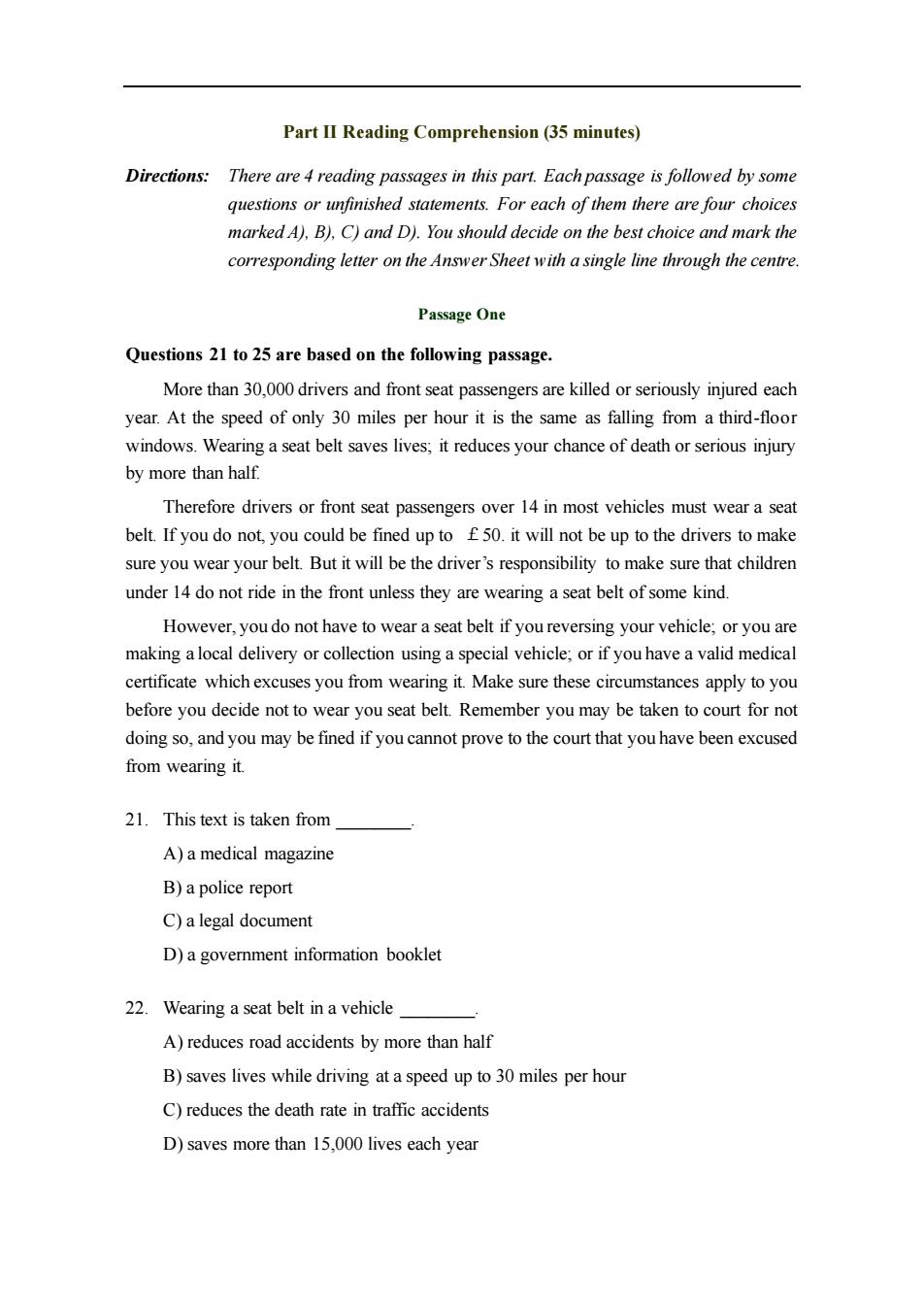
Part II Reading Comprehension (35 minutes)Directions:There are 4 reading passages in this part Eachpassage is followed by somequestions or unfinished statements. For each of them there are four choicesmarked A).B),C)and D).You should decide on the best choiceand mark thecorrespondingletterontheAnswer Sheetwithasingle linethroughthecentre.Passage OneQuestions 21 to 25 are based on the following passage.More than 30,000 drivers and front seat passengers are killed or seriously injured eachyear. At the speed of only 30 miles per hour it is the same as falling from a third-floorwindows. Wearing a seat belt saves lives, it reduces your chance of death or serious injuryby more than half.Therefore drivers or front seat passengers over 14 in most vehicles must wear a seatbelt. If you do not, you could be fined up to f 50. it will not be up to the drivers to makesure you wear your belt. But it will be the driver's responsibility to make sure that childrenunder 14 do not ride in the front unless they are wearing a seat belt of some kind.However, you do not have to wear a seat belt if you reversing your vehicle; or you aremaking a local delivery or collection using a special vehicle; or if you have a valid medicalcertificate which excuses you from wearing it. Make sure these circumstances apply to youbefore you decide not to wear you seat belt. Remember you may be taken to court for notdoing so, and you maybefined if you cannot provetothe court that youhave been excusedfrom wearing it21.This text is taken fromA) a medical magazineB) a police reportC) a legal documentD)a government information booklet22.Wearing a seat belt in a vehicleA) reduces road accidents by more than halfB) saves lives while driving at a speed up to 30 miles per hourC)reducesthedeathrateintrafficaccidentsD) saves more than 15,000 lives each year
Part II Reading Comprehension (35 minutes) Directions: There are 4 reading passages in this part. Each passage is followed by some questions or unfinished statements. For each of them there are four choices marked A), B), C) and D). You should decide on the best choice and mark the corresponding letter on the Answer Sheet with a single line through the centre. Passage One Questions 21 to 25 are based on the following passage. More than 30,000 drivers and front seat passengers are killed or seriously injured each year. At the speed of only 30 miles per hour it is the same as falling from a third-floor windows. Wearing a seat belt saves lives; it reduces your chance of death or serious injury by more than half. Therefore drivers or front seat passengers over 14 in most vehicles must wear a seat belt. If you do not, you could be fined up to £50. it will not be up to the drivers to make sure you wear your belt. But it will be the driver’s responsibility to make sure that children under 14 do not ride in the front unless they are wearing a seat belt of some kind. However, you do not have to wear a seat belt if you reversing your vehicle; or you are making a local delivery or collection using a special vehicle; or if you have a valid medical certificate which excuses you from wearing it. Make sure these circumstances apply to you before you decide not to wear you seat belt. Remember you may be taken to court for not doing so, and you may be fined if you cannot prove to the court that you have been excused from wearing it. 21. This text is taken from _. A) a medical magazine B) a police report C) a legal document D) a government information booklet 22. Wearing a seat belt in a vehicle _. A) reduces road accidents by more than half B) saves lives while driving at a speed up to 30 miles per hour C) reduces the death rate in traffic accidents D) saves more than 15,000 lives each year